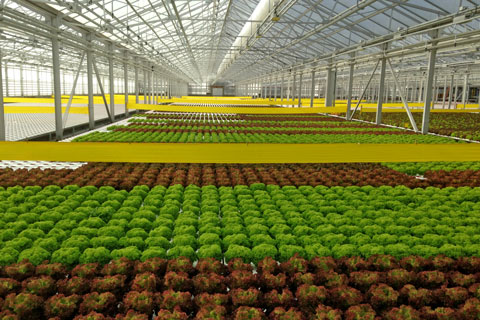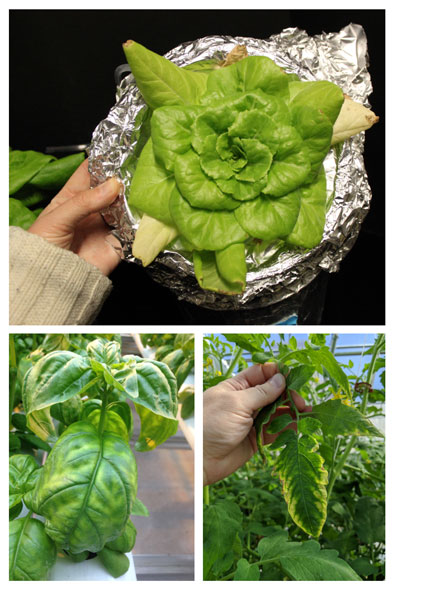8/1/2022
A Balancing Act
David Kuack

Regardless of which food crops you’re growing in a controlled environment, you have to make sure the plants are receiving the right amount of nutrients at the right time to ensure you produce a high-quality crop. Leafy greens are a relatively quick crop compared to vining crops like tomato and cucumbers. Leafy greens are typically grown using hydroponics, such as nutrient film technique (NFT) or deep-water culture ponds.
“Usually, there is a large reservoir in the case of NFT systems or there is the pond with deep water systems, which itself is the reservoir,” said Neil Mattson, horticulture professor at Cornell University in Ithaca, New York. “There is a large volume of nutrients that is directly being recirculated around the plant roots.”
Pictured: When using a recirculating system, the biggest issue is the plants aren’t taking up every nutrient at the same rate.
Photo courtesy of Neil Mattson, Cornell University.
Smaller growers usually operate two nutrient stock tanks to maintain reservoir nutrient levels. One of them contains calcium nitrate and other compatible nutrients. The second tank contains nutrients that aren’t compatible with calcium nitrate, which are typically sulfates and phosphates. A third stock tank may be used for pH adjustments.
“Monopotassium phosphate and magnesium sulfate are common fertilizer ingredients, so they have to be physically separated from calcium nitrate,” Neil said. “If these incompatible ingredients were to be combined in the same stock tank then precipitation would occur. Sludge would form and build up on the bottom of the stock tank. The stock solution would have to be discarded, the tank would have to be cleaned and a new fertilizer solution would have to be prepared. There is nothing a grower can chemically do to get the fertilizers back into solution once this precipitate forms.”
Leafy crop growers use the two nutrient stock tanks to make a single diluted nutrient solution, changing the electrical conductivity (EC) with the crop growth and/or crop type. For vining crops, like tomatoes, as few as two stock tanks can be used, but the fertilizer recipe for each set of stock tanks will differ depending on the stage of growth. One recipe is for vegetative growth when plants first start to grow. A second recipe is used when fruit set begins. A third recipe is applied when the fruit harvesting starts and is used throughout the harvesting phase.
Dealing with nutrient imbalances
When using a recirculating system, the biggest issue with the nutrients as the water is recirculated is the plants aren’t taking up every nutrient at the same rate.
“Depending on the environment and the crop, the plants may take up more nitrogen than phosphorus or calcium,” said Stacy Tollefson, director of cultivation at Aeriz Cannabis in Phoenix, Arizona. “There may be a greater loss of nitrogen in the nutrient solution than a calcium loss. There might even be a calcium buildup if the environment is humid and the plant transpiration rate is low, or conversely if it is too hot and dry and the transpiration rate is very high. Both general plant nutrient demand and environmental conditions can start to create an imbalance of nutrients in the reservoir.
“Generally, from the start of a vining crop, these nutrient imbalances don’t usually occur for a couple months. Taking a water sample from the recirculating water tank and sending it to a lab for a full nutrient analysis, the results should tell growers if the nutrient levels are on target as to what the plants should be receiving. As time goes on, the nutrient levels will decrease and become unbalanced.”
 For vining crops, Stacy recommends a nutrient mix sample be submitted for lab testing at least every two months.
For vining crops, Stacy recommends a nutrient mix sample be submitted for lab testing at least every two months.
“Growers can do a one-time adjustment into the sump tank based on the volume of the tank,” she said. “The nutrient levels can be adjusted back to the levels of the nutrient mix targets. If the nitrogen level is low, nitrogen should be added to bring that level back to what the plants should be receiving. That is going to take some balancing because if nitrogen is added, then calcium nitrate or potassium nitrate is going to be incorporated, so the need for these other nutrients has to be balanced when adding nitrogen.”
Pictured clockwise from Top:
• Nitrogen deficiency on lettuce showing symptoms of lower leaf yellowing. Photo courtesy of Neil Mattson, Cornell University.
* Nitrogen deficiency on lettuce showing symptoms of lower leaf yellowing. Photo courtesy of Stacy Tollefson, Aeriz Cannabis.
* Basil is sensitive to magnesium deficiency. Visual symptoms include interveinal chlorosis of the lower leaves. Photo courtesy of Neil Mattson, Cornell University.
Stacy adds growers shouldn’t be overly concerned with an excess of a nutrient such as calcium when trying to balance the nutrient mix.
“Growers could add water to dilute the calcium, and then add both nitrogen and calcium to get back to target levels,” she said. “It requires a little give and take when trying to adjust the nutrient levels back to where they need to be. But growers need to know what those targets should be based on the nutrients that are being delivered to the plants. This is why regular testing is so important.”
Stacy said smaller growers can be more hands-on, sending samples out for analysis, looking at the results and determining what to add.
“Large growers are likely going to have an injection system that can incorporate multiple fertilizers,” she notes. “These growers can look at a sample test analysis and add the necessary nutrients to bring them up to target levels. Growers still need to send out samples for a full nutrient analysis, especially micronutrients.”
Nutrient deficiency issues tend to show up more often when temperatures are hot because plants take up more water than nutrients.
“It is a much more dynamic system when there is a higher transpiration rate,” Stacy said. “During the summer, growers of vine crops may consider doing a nutrient analysis more often than every two months.”
The nutrient she sees out of balance more often with vining crops is potassium.
“Sometimes there may also be a buildup of calcium if the transpiration rate is low. If the temperature is hot and the humidity is high, there is not going to be as much calcium pulled into the plants,” she said. “This might lead to a higher level of calcium in the nutrient solution than what’s expected. But there might not be a negative effect on the plants. Some blossom end rot may occur on tomatoes, but that’s when the grower has to adjust the environmental conditions. Sometimes there is a calcium buildup in the tank and the potassium level drops very quickly.”
Lettuce, which is a fast-growing crop, shows nutrient deficiencies quicker than vine crops.
“Nitrogen, phosphorus and potassium deficiencies appear relatively quickly,” Neil said. “Calcium, magnesium and sulfur may build up over time.
“Lettuce tends to be more tolerant of iron deficiency than some other leafy greens. Arugula and basil are more sensitive to iron deficiency. Basil is also quite sensitive to magnesium deficiency. Leafy greens are quick-turn crops, so they are going to show deficiencies within a week or two, which means growers need to be very proactive in monitoring their crops.”
Sodium buildup
One of the issues that occurs for both leafy greens and vining crops if the nutrient solution is captured and reused is the buildup of sodium.
According to Neil, there can be small amounts of sodium already in the irrigation water or as an impurity in the fertilizer. It contributes to the EC, but not the fertilizer value.
“Traditionally, what happens with growers when the sodium builds up to a certain threshold they dump the waste water and don’t reuse it,” he said. “A grower could adjust the ratio of recaptured water to fresh water, but at some point the sodium level is going to build up so that the waste water will eventually have to be dumped out and start fresh.”
Alternatively growers could use a reverse osmosis system to exclude any sodium from the irrigation water source. However, reverse osmosis would remove all the fertilizer nutrients, as well as sodium and chloride. Another option is the Ridder NoNa+ membrane electrolysis system, which only removes sodium from the water.
“Tomatoes are less sensitive to sodium than leafy greens,” Neil said. “Growers might have their own threshold values based on their experience. Essentially damage appears on the plants, including the roots, with salt accumulation in the leaves, which can lead to leaf spotting. Ultimately, there will be a reduction in plant growth and plant productivity.
“With lettuce, the plants might be smaller in size. Tomatoes, even though they are more tolerant of sodium, at excessive levels there could be reduced fruit yields.”
Monitoring pH and EC
Growers of leafy greens who use one fertilizer solution normally try to maintain a pH of 5.5 to 6.0 so all nutrients are available. Growers producing a few major crops or a monoculture crop might formulate the fertilizer solution specifically for their main crop, like basil.
“pH affects the solubility and the availability of nutrients in water or in the plants themselves,” Neil said. “Several micronutrients become insoluble at high pH, including iron, manganese and zinc. For those nutrients to be available to the plants, depending on the crop, the pH has to be kept at less than 6.5 and less than 6.0 ideally, in the case of lettuce and other leafy greens. Other elements like calcium and magnesium become insoluble and not available to the plants to take up at low pH.”
Measuring the EC only provides the total salts and doesn’t specifically identify the elements that make up that measurement. Neil said there are devices available that measure the individual elements. CleanGrow is a handheld nutrient meter that looks similar to an EC or pH pen. It works through ion-selective membranes and measures six specific ions (e.g., calcium, potassium, magnesium, sodium, nitrate and phosphate). Growers can use the meter to check the nutrient levels in a deep water pond or the reservoir and then make the necessary nutrient adjustments.
Envonics makes a meter that does inline measurements and enables growers to log and track the data over the course of a day. It measures in real time, measuring EC, nitrate and potassium.
Stacy said in lieu of these real time measurements, tomato growers should be sending plant tissue samples to a lab every week or two for analysis. While it may take longer for nutrient deficiencies or excesses to have an impact on tomato plants, growers should be proactive and make adjustments sooner rather than later and not wait until symptoms start to appear on the plants.
“Regardless of the operation size or the crop, growers are going to be making real time pH and EC adjustments,” she said. “Growers should take a leaf tissue sample every time they take a nutrient water sample. This will give them a picture of what is in the fertilizer tank and what the plants are taking up.
“If the analysis shows a low level of potassium in the fertilizer tank then the leaf analysis is going to show the plants are low in potassium. If the leaf tissue analysis doesn’t show a potassium deficiency, there will be one relatively soon. This will enable a grower to prevent a problem from occurring.” IG
David Kuack is a freelance technical writer in Fort Worth, Texas. Contact him at dkuack@gmail.com.